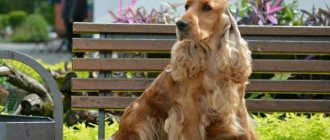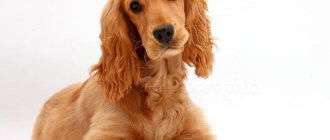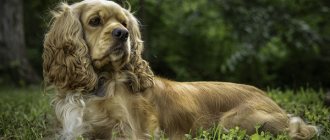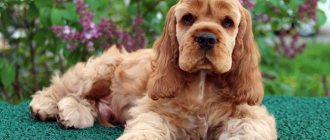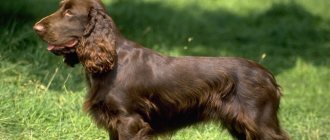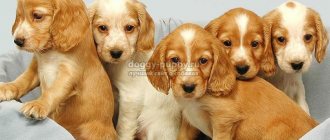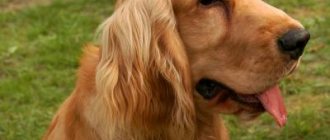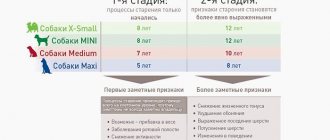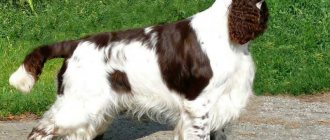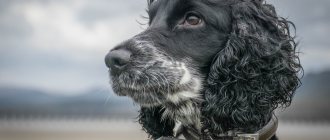Spaniels are the general name for a large group of breeds, which primarily includes hunting dogs, but also includes decorative and even dwarf pets.
The Mini Cocker Spaniel is a beautiful hunting dog of miniature size, considered the smallest among all gun breeds.
Despite the fact that they have not lost the hunting instincts of their ancestors, nowadays miniature cockers are much more often used as companions and family pets than for their original purpose.
They are also popular as participants in exhibitions and sports competitions, for example, freestyle skiing.
After all, in addition to their beautiful and impressive appearance, these dogs are very smart, quick-witted and willing to learn new skills.
Are there mini cocker spaniels?
There is no breed called a mini cocker spaniel . Usually, when it comes to the smallest cockers, we mean dogs of the American Cocker Spaniel breed.
All advertisements for the sale of mini cocker spaniels are either fraudulent, when breeders try to sell ordinary English or American cockers under the guise of a rare breed, or the puppies offered suffer from a genetic disease called dwarfism.
It is also likely that puppies sold as Miniature Cocker Spaniels were simply deliberately underfed by the breeder so that they could be sold for more than standard-sized puppies .
Breed standard
Proportional dogs are small in size. Body weight – 10-15 kg. Height – 35-38 cm. Doggies have a round head, proportional to the whole body. The brow ridges are strongly pronounced. This breed has a wide muzzle with developed nostrils.
The nose can be black or brown. The shade depends on the color. The eyes are characterized by black color. They are distinguished by their almond shape. The deep gaze of dogs of this breed is legendary.
Black and white American cocker spaniel
Dogs have a scissor bite. They have long floppy ears, which can be called the hallmark of the breed. The neck is muscular and elongated. The torso is characterized by a line of the back directed downwards towards the lumbar region.
The back does not bend. The doggies' chest is wide and deep. Their legs are parallel to each other. Paws are straight with well-developed muscles and bones.
It is customary to dock a dog's tail. This was due to the fact that during hunting in the grounds the dogs often wagged their tails and drew blood from them. Dog owners began to dock long tails, leaving their pets a small section that included four vertebrae.
Tail docking has been found to improve the conformation of the breed. However, now, due to the fact that dogs have become decorative, tails are often not docked. In some countries this operation was even banned, considering it inhumane.
Dogs' fur can be straight or wavy. On the head it is short, and on the body it is of medium length. The chest, belly, paws and ears are characterized by long hair that needs to be trimmed periodically. The fur is soft throughout the body.
American cocker spaniel sadly waiting for his owner
The color varies:
- Ginger
- Black (there is a black American Cocker Spaniel with tan marks)
- Brown (chocolate)
- Light fawn
- White with spots of different colors: black, red, brown
Ideally, the edge of the ear (excluding fur) should reach the tip of the nose. Dogs live 12-15 years.
Origin story and what it looks like in the photo
Spaniels, whose homeland is Spain, were brought to Britain back in the 12th century AD.
Already by the 14th century, the breed was divided into water and land spaniels. With the former they hunted water game, and with the latter they hunted land game, and it was from a small variety of land spaniels that cockers originated. They hunted with them mainly small birds, mainly woodcocks.
In 1620, cockers were brought to the New World, and from that time a new stage in the development of this breed began. However, at this time it was not yet possible to talk about their American variety as a separate breed.
Even in the second half of the 19th century, when English cockers were already officially recognized and took part in exhibitions, American-bred dogs continued to be crossed with them, although by that time they were already somewhat different from the original breed in their appearance.
The ancestor of the American cocker is considered to be a dog named Obo the Second, born in the USA in August 1882 and distinguished by its very small size for dogs of that time: his height was only 25 cm at the withers.
Despite the fact that Obo the Second was very different from modern cockers in physique and had a very stretched body, he was considered very good in conformation for his time and became an outstanding sire.
At the beginning of the 20th century, standards were developed on both sides of the Atlantic and even then it became clear that the American variety of cockers was very different from the English one.
In 1935, the final division took place: English-type dogs were recognized as standard cockers, and American ones were excluded from breeding.
However, in 1946, the AKC recognized the American variety as a separate breed, after which international recognition of these dogs took place..
History of origin
Two countries are considered the birthplace of the continental toy spaniel: France and Belgium. In appearance, they resemble royal toy spaniels.
Despite the fact that the breed did an excellent job of herding, over time, toy spaniels became completely decorative pets - companions. Their noble appearance allowed them to become permanent residents in palaces. They were considered attributes of the nobility and accompanied their mistresses everywhere. Paintings by Rubens, Titian, Clouet and other 15th century painters depict dogs that closely resemble continental toy spaniels. Henry III, Louis XIV, XV, XVI, Madame de Pompadour became the first famous owners of these miniature dogs. Queen Marie Antoinette of France especially singled out this breed; her favorites were given a separate palace with ladies-in-waiting for their care. It is known that the faithful pet even accompanied the mistress to the death penalty.
The first toy spaniels came to England only in 1905. Gradually, the breed began to spread around the world, but until now it has not become widely known and popular.
You may be interested - Japanese Chin
Character traits
Miniature Cockers are lively, energetic and playful dogs that are intelligent, quick-witted and inquisitive.
They are very friendly towards people, become very attached to their owners and are great with children..
At the same time, if desired, such a pet can be raised into a wonderful hunting assistant, which, despite its small size, will track, fly, and even bring shot game to its owner no worse than other spaniels.
Mini Cockers are also suitable as sports dogs and, although disciplines such as dragging loads are unacceptable for them, many American Cockers show excellent results in agility, freestyle and other sports that require agility and artistry.
Expert opinion
Kozhevin Semyon Kirillovich
Expert dog handler.
“The Mini Cocker Spaniel, despite its small size, is agile, agile and energetic. This is a dog that is equally suitable as a pet or a working dog. However, mini-cockers are not often used nowadays for their original purpose, since many hunters are not satisfied with the labor-intensive care of their coat, and therefore they prefer shorter-haired breeds. But at the same time, thanks to their spectacular appearance and friendly disposition, American cockers are popular as pets and show dogs.”
Character and intelligence
In terms of intelligence, the continental toy spaniel is always placed in the overall top and among the leaders among decorative breeds. In terms of ability to train, the ability to quickly and correctly make independent decisions, and early socialization, Papillons (continental toy spaniels in general) are superior to other decorative dogs. They are second only to poodles. Both of them are hunting dogs, which by nature have well-developed intuition, intelligence, an obedient character, are human-oriented, and lack aggression.
Attitude towards children and others
Papillons and Phalenes are gentle and affectionate in the family, they love noisy and active games, especially with children. They often become good watchmen, signaling with a voice the arrival of strangers or the appearance of strange animals. Dogs are brave in everyday life and in stressful situations, and cowardice for toy spaniels is a disqualifying fault.
Advantages and disadvantages
pros:
- Beautiful appearance.
- Very smart and quick-witted.
- They are loyal to their owners and love to please them.
- Friendly attitude towards people.
- They get along well with children.
- Not aggressive towards other pets.
- Playfulness and energy.
- Small convenient size.
Minuses:
- Quite labor-intensive and expensive grooming and the need for haircuts.
- Needs long walks.
- Quite gluttonous and prone to obesity.
- Excessive trust in strangers.
- Hunting instincts can cause a pet to escape if a mini cocker rushes to chase a bird or, for example, a neighbor's cat.
Dimensions, weight and other distinctive features
| Options | Data |
| Height | Males - 38-40 cm Bitches - 35-36 cm |
| Weight | Males – 11-15 kg Bitches – 8-10 kg |
| Frame | Strong and compact, with a strong, straight back and a moderately broad, well-developed chest. |
| Head | Harmonious and proportional to the body, with a well-defined stop. The length of the muzzle, shaped like a square, should be approximately half the total length of the head. |
| Ears | Long, hanging, set low - in line with the eyes. |
| Eyes | Large, expressive, always dark, almond-shaped or round. The expression of the eyes is benevolent and meek. |
| Nose | Depending on the color, it can be either black or brown. |
| Neck | Elongated, graceful, slightly curved. |
| Limbs | Strong and strong, without signs of disintegration. |
| Tail | Previously, it was docked in puppyhood, but now it can be left at natural length, since this does not contradict the breed standard. |
| Wool | Straight or slightly wavy. Quite short on the head, but long on the ears and body. At the bottom of the body and on the paws it forms a so-called skirt. The coat is silky and pleasant to the touch, without the slightest signs of coarseness or, conversely, excessive fluffiness and cottoniness. |
| Color | It can be either one-color (fawn, red, brown, black), or two-color or three-color. Black and tan and brown American cockers are also found. |
The edge of the dog's ear, if extended in length, should reach the edge of the nose with its tip.
Description of the breed with photos
In the breed standard, the countries of origin of the continental toy spaniel are indicated as France and Belgium (it is not possible to establish more precisely due to the long-standing history). The main purpose is a companion, decorative dog. Although the name of the breed contains the word “spaniel”, which is associated with hunting dogs, the Papillon and Phalene are not used in this capacity.
If the Toy Spaniel breed is described in a few phrases, then it is a small dog with long hair, a cheerful character and an elegant bone structure. Let us dwell on the description of the breed in more detail.
The Continental Spaniel's head is small and rounded. The muzzle is almost sharp, the transition from the forehead to the muzzle is clearly defined. Nose is black. The eyes are round, dark, and set low. The lips are thin and have a scissor bite. The ears are thin, large, erect in Papillon Toy Spaniels, semi-erect in Phalene Spaniels; widely spaced. The ears have long hair, the so-called “fringe”. The neck is set high, the chest is deep. The stomach is tucked, the back is straight. The limbs are straight, parallel, fairly short, fine-boned. The tail is covered with long, thick hair, set high, and carried over the back.
The closest relative is the dwarf German Spitz.
Size and weight
The Continental Toy Spaniel is a small breed due to its size. Weight ranges from 1.5 to 4.5 kg, with two weight categories distinguished: standard dogs weigh 2.5-4.5 kg, and mini dogs weigh 1.5-2.5 kg. Height 20-28 cm , There are no mandatory values, but in general the physique should look harmonious.
Color and coat type
The standard allows two types of colors for Papillons and Phalenes: two-color and three-color. Moreover, the predominant color should be white, but spots must stand out on it. The spots can be anything (large, small, red, black, etc.), but not blue. White ears are not welcome, but a white streak (vein) on the face is desirable, and the spots on its sides should be symmetrical.
There are three possible colors:
- black and white;
- white and sable;
- tricolor (a mixture of white, black and sable).
Of all the puppies, ordinary amateur buyers choose three-colored pets, and breeders prefer two-colored animals for future breeding.
Like many other spaniels, the Continental Toy Spaniel (Papillon and Phalene) has “freckles” on the face and paws, that is, dotted spots on the main background, but they are not required.
The coat of continental toy spaniels is silky, quite long, reaching 7 cm. On the ears and tail, the hairs grow up to 15 cm. On the back sides of the legs, the elongated hair forms “pants”. This type of coat requires daily care. The shortest hairs are on the muzzle and the front sides of the paws. There is no undercoat.
Varieties of the Toy Spaniel breed
Depending on the structure of the ears, two varieties of continental toy spaniel are distinguished. The erect ears belong to the Papillons (a newly bred breed), and the semi-erect ears belong to the Phalenes (thus the royal dwarf spaniels). Papillons have long hair covering the entire inner side of the open, erect ear. Fans of the breed prefer Papillons. There is a cross between Phalene and Papillon, in which the ear is open, but not overgrown with hair, or, for example, only a small tip of the ear hangs down. These features are considered a disadvantage of the breed.
There are also varieties in the description of the spaniel breed, or subspecies: depending on the weight, standard and mini continental toy spaniels are distinguished.
Papillon Phalen
Lifespan
The average lifespan of miniature cockers is 13-15 years.
However, dogs of this breed may be susceptible to the following diseases::
- Dysplasia
- Cataract
- Progressive retinal atrophy
- Corneal dystrophy
- Glaucoma
- Hemolytic anemia.
- Allergy
- Otitis and other inflammatory diseases of the ears.
- Dilactation cardiomyopathy.
- Epilepsy
The life expectancy and health status of a pet primarily depends on its heredity and conditions of detention..
What diseases is the breed susceptible to?
The average lifespan of a continental toy spaniel is 12-15 years. There are a number of diseases that occur more often in this breed than others:
- entropy - turning of the eyelids
- cataract, corneal dystrophy, progressive retinal atrophy, conjunctivitis. If you notice increased lacrimation, the appearance of discharge, redness of the eye, clouding of the mucous membrane, you should show your dog to a veterinarian
- diseases of the musculoskeletal system - dislocation of the kneecap
- congenital deafness
- diseases of the hearing organs - if there is an unpleasant odor, increased formation of sulfur, the dog shakes its head and scratches its ears, you must immediately seek help from a veterinary clinic.
Care and maintenance
Caring for the coat of these dogs is quite difficult. Miniature cockers need bathing no more than once a week. In this case, it is necessary to use special cosmetics that will not only make your pet’s fur clean, but also improve its quality.
Brush your cocker regularly to prevent tangling of the coat . In addition, dogs of this breed require periodic haircuts.
Due to the fact that American Cockers can be susceptible to allergies, it is recommended to use hypoallergenic shampoos and conditioners when washing them.
Your pet’s long ears need to be inspected every day and cleaned if dirty..
The visible part of the ear canal of a miniature cocker is cleaned with cotton swabs and a special lotion, and the inside of the ear is wiped with a damp cloth.
IMPORTANT!
The dog's eyes can be wiped with cotton swabs soaked in a special eye cleaner.
The claws are trimmed with a nail clipper as they grow, that is, when their tips begin to curl inward.
The Miniature Cocker's teeth also need care: they need to be periodically cleaned and the condition of the gums monitored.
It is recommended to clean them using special treats or toys, but if plaque is not removed by these methods, then you can brush the animal’s teeth with a brush and toothpaste for dogs.
In the same case, if hardened plaque appears on the teeth, you should contact a veterinary clinic to have it removed.
Cavalier King Charles Spaniel - a small dog with an interesting destiny
Not long ago, a new star from the animal world emerged on the Internet and is rapidly gaining popularity among the widest public. The charming dog Nessa belongs to the breed with the intricate name Cavalier King Charles Spaniel and amazes with its incredibly miniature size.
Nessa weighs only a little over 3 kilograms, while the weight of an ordinary dog of this breed is about 6 kilograms! At the same time, the shaggy little one is completely healthy, cheerful and looks great. The secret is that Nessa was the youngest puppy in the litter; the bulk of the “building materials” went to her more fortunate brothers and sisters. Although why “more fortunate”, because none of them could become famous like Nessa! Admire the beauty in the profile of nessathecavalier
The story of the little dog has revived increased interest in the breed with an incredibly complex name. Cavalier King Charles Terrier - for a reader familiar with the basics of the English language, each word of this bizarre construction is completely understandable, but what made them unite together? Let us immediately make a reservation that the complex name of the breed fully reflects its incredibly meaningful fate. Every word is a historical turn on the way to the dog that little Nessa proudly represents today.
It will be interesting:
- The story of this dog shocked Britain and became known throughout the world.
- Unicorn puppy: nature's incredible joke
- New Year's miracle: three stories of dogs who found their owners on New Year's Eve
- A fictional story about events that have happened and will happen
In the beginning there was the spaniel - a magnificent hunting dog, whose ancestral home is considered to be medieval Spain. The next “ingredient” of the breed was small Asian dogs, which were exported as curiosities by traders and travelers to Europe - Japanese chins. Spaniels and chins found each other cute and gave birth to charming offspring - toy spaniels, which quickly gained popularity among the European aristocracy. These dogs have inherited the best traits of their ancestors, making them ideal companions for their owners.
However, human morals are changeable - unlike his predecessors, the famous ruler of England and Holland, William III of Orange, was very fond of pugs, and actively “promoted” this breed among his subjects. Toy spaniels also had to adapt to the tastes of the monarch. The dogs, which were also nicknamed King Charles in memory of their former benefactor, under the pressure of fashion trends began to acquire the characteristic features of pugs - a flattened muzzle and low-set ears. It would seem that the time had come to put an end to this story - but that was not the case.
At the very beginning of the 20th century, a group of enthusiastic dog handlers decided to revive the King Charles Spaniel in its original form. Through their efforts, the world was enriched with a new breed of dog, which truly had the best features of the pre-Oran Toy Spaniels. She received a new prefix to her already rich name - cavalier. Within a few decades, the breed earned recognition throughout the world. And half a century later Nessa was born.
So what are they, Cavalier King Charles Spaniels? In their “weight category” these pets are almost perfect! They contain the qualities that attract most inexperienced owners of small dogs. A bizarre combination of various ancestors turned the gentleman into something like a charming soft toy that you just want to pick up. The dog's character is appropriate - it does not have any aggression inherent in some miniature breeds. This is especially important if the future owner does not have sufficient experience in keeping and training animals - the gentleman will become an excellent companion for him, who himself will be able to teach his person a lot.
The only serious concern that the owner of a Cavalier King Charles Spaniel will certainly face is the mandatory and regular care of the pet’s coat. This dog’s “coat” is a real calling card of the breed; its quality is inextricably linked with the animal’s health. Therefore, the matter cannot be accomplished without thorough bathing. It is advisable to carry them out at intervals of 10 days, and after each walk the gentleman’s coat should be wiped with a damp towel. And don't forget about combing! By doing this, you will not only tuck unruly hairs in the right direction, but also give your dog a light massage.
Otherwise, caring for a Cavalier King Charles Spaniel is not much different from caring for most purebred dogs - high-quality nutrition, timely walking (at least twice a day) and regular medical examinations. And be sure to communicate, a lot of communication! Like most companion dogs, the Cavalier feels like his owner’s “pocket” animal. For this, he was once loved at the royal court, and for this, the Cavalier King Charles Spaniel has gained popularity in our time.
We will be grateful if you support us on our Zen channel! Thanks friends!
Nurseries where you can buy these cuties
If you find an error, please select a piece of text and press Ctrl+Enter.
Alexey Egorov
Author, employee of “My good one”. Having an attachment to things with history, he constantly strives to learn new things and discover something unusual, something that has not yet been tried. Loves the vastness of the oceans, mountains, fields and the feeling of unity with nature.
+2
Proper feeding
You can feed mini cocker spaniels natural food or ready-made food no lower than super-premium, or better yet, holistic-class. At the same time, if the dog is prone to allergies or obesity, you should opt for a special dietary food.
When feeding natural food, the basis of the diet should be cut into pieces and scalded raw lean meat.
You should add chopped vegetables (raw or boiled), as well as fermented milk products, such as cottage cheese or kefir.
When feeding your pet naturally, it is also necessary to add vitamins and mineral supplements to your pet’s food..
Training and education
From the age of 2 months, the Cocker Spaniel is taught the basic commands: “Place”, “Sit”. At this age, it is important to teach the puppy all the basics, because it is more difficult to train with an older dog. Cocker Spaniels are easy to train because they are a hunting breed. The main thing in education is systematicity. A special feature of cocker training is the need for frequent repetitions.
Experienced dog handlers advise starting training from the moment the puppy gets into the house. This is training to use a tray and a collar. You should train him to use a leash at home so that it doesn’t become stressful for your pet. At 4 months, a cocker spaniel should know the basic commands: “Sit”, “Lie down”, “Toe”.
Attention! The most difficult period begins at 6 months, when the puppy becomes a teenager. At this time, he may show disobedience and stubbornness.
The owner should be patient and continue systematic training. Thus, the owner will also designate a place in the hierarchical chain. After each lesson, you need to reward your pet to stimulate further communication.
How to choose?
First of all, you should decide on the gender, color and quality of the future pet. If you decide to buy a show-class cocker, and gender does not matter, then it is better to opt for a male, as they look more impressive in the rings.
However, it should be taken into account that girls are more affectionate and obedient, and therefore, if there are children in the house, it is better to buy a bitch.
You should only buy a dog in a kennel or from a breeder, since purchasing a cocker on the market, and even without the puppy having documents of origin, can be fraught with the purchase of a mestizo, and not a purebred spaniel.
When choosing a baby from a litter, you need to carefully examine it to make sure that its appearance meets the standard requirements, and that its eyes, nose, ears and skin are clean and healthy.
CAREFULLY!
It is not recommended to purchase a puppy that shows anger towards people, cowardice or nervousness.
Also, you should not buy babies that are too small in size, since these puppies are often either undernourished or suffer from a hereditary disease such as dwarfism or, in other words, dwarfism.
Character
The Continental Toy Spaniel quickly becomes attached to its owners and its new home. He has an affectionate, soft, friendly disposition.
Falen loves to have fun, he not only likes to frolic himself, he tries to involve all household members in his games. Phalenes have an inexhaustible supply of energy.
The toy spaniel is especially attached to its owner. He loves him so much that he begins to be jealous not only of strangers and pets, but also of family members.
Jealousy is expressed by growling and disobedience. Noticing such manifestations of aggression in a small dog, people often simply chuckle, since the growling falen looks really funny.
This is a big mistake. Any manifestations of aggression must be suppressed, otherwise the dog will become uncontrollable and even vicious. Because of jealousy, she can not only growl, but also bite, which is unacceptable.
Correction of unwanted behavior is required from the first moments of its manifestation.
A well-mannered falen is friendly towards children, plays with pleasure and has fun in their company. An ill-mannered, unsocialized dog can show aggression towards a child, often it can manifest itself as a response to children's pranks.
It is important to show the pet that the child is higher than the dog, otherwise the dog will imagine itself to be senior in rank.
It is also important that children treat phalene with care, love and care. Representatives of this breed can be easily injured.
The toy spaniel is not only a cheerful friend, a devoted companion. He may well serve as a watchman.
He treats house guests with distrust and will not allow familiarity. You should not immediately try to pet a cute-looking dog; in response, he may show his sharp teeth.
He communicates calmly, even friendly, with other pets. It is interesting that if a falen can immediately start a game with a small dog and quickly make friends, then the relationship with a large dog does not work out so well.
A small spaniel would rather bark at a large dog than show friendliness.
It is worth noting that each dog is individual in its own way. Her behavior and the degree of manifestation of her character traits depend largely on her upbringing and environment.
So it is not surprising that some falens are able to make friends with a cat, a parrot or a huge St. Bernard and from the first minute start playing with a complete stranger.
